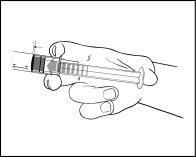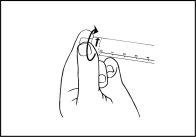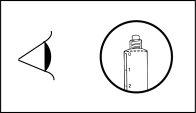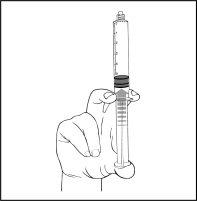

ATROPINE Aguettant 0.2 mg/ml Injectable Solution in Pre-filled Syringe


How to use ATROPINE Aguettant 0.2 mg/ml Injectable Solution in Pre-filled Syringe
Introduction
Package Leaflet: Information for the User
ATROPINE AGUETTANT 0.2mg/ml, Solution for Injection in Pre-filled Syringe
Atropine, sulfate
Read all of this leaflet carefully before you start using this medicine because it contains important information for you.
- Keep this leaflet, you may need to read it again.
- If you have any further questions, ask your doctor or pharmacist.
- This medicine has been prescribed for you only. Do not pass it on to others. It may harm them, even if their signs of illness are the same as yours.
- If you get any side effects, talk to your doctor or pharmacist. This includes any possible side effects not listed in this leaflet. See section 4.
The name of this medicine is Atropine Aguettant 0.2 mg/ml Solution for Injection in Pre-filled Syringe, it will be referred to as Atropine Aguettant throughout this leaflet.
Contents of the pack
- What is Atropine Aguettant and what it is used for
- What you need to know before you use Atropine Aguettant
- How to use Atropine Aguettant
- Possible side effects
- Storage of Atropine Aguettant
- Contents of the pack and other information
1. What is Atropine Aguettant and what it is used for
Atropine belongs to a class of medicines called anticholinergics. An anticholinergic is a substance that blocks the neurotransmitter acetylcholine in the central and peripheral nervous system. It is used in emergency situations, when the heart beats too slowly, as an antidote for cases of poisoning by organophosphorus insecticides or nerve gas, for example, and for cases of poisoning by mushrooms.
It can be used as part of the pre-medication before general anesthesia. It can also be used to prevent the side effects of other drugs used to counteract the effects of muscle relaxants after surgery.
Atropine Aguettant 0.2 mg/ml Solution for Injection in Pre-filled Syringe is used to treat adults only.
2. What you need to know before you use Atropine Aguettant
Do not use Atropine Aguettant:
- if you are allergic (hypersensitive) to atropine or any of the other ingredients of this medicine (listed in section 6);
- if you have urinary problems;
- if you have high pressure in the eye (glaucoma);
- if you suffer from esophageal disease (esophageal achalasia), intestinal blockage (paralytic ileus) or a form of acute colonic distension (toxic megacolon).
These contraindications do not apply in cases of potentially life-threatening emergencies.
Warnings and precautions
Consult your doctor before starting to use Atropine Aguettant if you suffer from:
- hyperthyroidism;
- prostate disease;
- heart failure;
- liver or kidney disease;
- certain heart diseases;
- stomach disease, such as pyloric stenosis;
- chronic bronchitis;
- fever;
- if you are an elderly person;
- severe myasthenia (severe muscle weakness);
- heartburn (reflux).
Using Atropine Aguettant with other medicines
Tell your doctor or pharmacist if you are taking, have recently taken or might take any other medicines:
- tricyclic antidepressants;
- certain antihistamines;
- medicines for Parkinson's disease;
- phenothiazine, clozapine or neuroleptic drugs (for mental illnesses);
- quinidine or disopyramide (for heart diseases);
- antispasmodics (for irritable bowel syndrome).
Pregnancy and breast-feeding
Pregnancy
Limited data on the use of atropine in pregnant women indicate that there are no adverse effects on pregnancy or fetal health. Atropine crosses the placenta. Intravenous administration of atropine during pregnancy or at term may cause a faster heart rate in the fetus and mother. This medicine should only be administered during pregnancy after careful consideration of the benefits and risks of treatment.
Breast-feeding
Small amounts of atropine may pass into breast milk and have effects on the infant. Atropine may inhibit milk production. Your doctor will weigh the benefit of breast-feeding against the benefit of treatment. If treatment is decided, breast-feeding should be interrupted. However, if breast-feeding is continued during treatment, your doctor will perform additional tests on the infant.
If you are pregnant or breast-feeding, think you may be pregnant or are planning to have a baby, ask your doctor or pharmacist for advice before using this medicine.
Driving and using machines
The injection of atropine can cause confusion or blurred vision. You should not drive or operate machinery after receiving an injection.
Atropine Aguettant contains sodium
This medicine contains less than 23 mg (1 mmol) of sodium per dose, so it is essentially "sodium-free".
3. How to use Atropine Aguettant
Your doctor will decide the correct dose for you and how and when the injection will be administered.
The recommended dose is:
As pre-medication before anesthesia
Adults: 0.3-0.6 mg intravenously immediately before induction of anesthesia or 0.3-0.6 mg intramuscularly, 30-60 minutes before anesthesia.
To counteract the effects of muscle relaxants:
Adults: 0.6-1.2 mg intravenously with neostigmine.
In case of low heart rate, heart block or cardiac arrest:
Adults:
- Sinus bradycardia (low pulse rate): 0.5 mg intravenously, every 2-5 minutes until the desired heart rate is achieved.
- AV block (blockage of the transmission of contraction between the atrium and ventricle): 0.5 mg intravenously, every 3-5 minutes (maximum 3 mg).
As an antidote for organophosphate poisoning (insecticides or nerve gas), anticholinesterases or poisoning by muscarinic mushrooms:
Adults: 0.5-2 mg depending on the characteristics and response of the patient, may be repeated after 5 minutes and subsequently as required.
If you have any further questions on the use of this product, ask your doctor or pharmacist.
This injection will be administered by a doctor or nurse, so it is unlikely that you will receive an overdose of atropine. If you think you have been given too much atropine, feel that your heart is beating very fast, breathe rapidly, have a high fever, feel restless, confused, have hallucinations or lose coordination, you should inform the person who administered the injection.
4. Possible side effects
Like all medicines, this medicine can cause side effects, although not everybody gets them.
Side effects depend on the dose you receive and usually disappear with the interruption of treatment.
Rarely, an allergic reaction may occur. This can cause skin rashes, intense itching, skin peeling, swelling of the face (especially around the lips and eyes), throat tightness and difficulty breathing or swallowing, fever, dehydration, shock and fainting. All these are very serious side effects. Tell your doctor immediately if you experience any of these side effects. You may need urgent medical attention.
Very common side effects (may affect more than 1 in 10 people)
- visual disturbances (pupil dilation, difficulty focusing, blurred vision, light intolerance);
- reduced bronchial secretion;
- dry mouth (difficulty swallowing and speaking, feeling of thirst);
- constipation and heartburn (reflux);
- reduced gastric acid secretion;
- loss of taste;
- nausea;
- vomiting;
- feeling of bloating;
- lack of sweating;
- dry skin;
- rash;
- eruption.
Common side effects (may affect up to 1 in 10 people)
- excitement (especially with higher doses);
- loss of coordination (especially with higher doses);
- confusion (especially with higher doses);
- hallucinations (especially with higher doses),
- excessive temperature;
- certain heart disorders (fast heart rate, irregular heart rate, temporary slowing of heart rate);
- flushing;
- difficulty urinating.
Uncommon side effects (may affect up to 1 in 100 people)
- psychotic reactions.
Rare side effects (may affect up to 1 in 1,000 people)
- allergic reactions;
- seizures (convulsions);
- drowsiness.
Very rare side effects (may affect up to 1 in 10,000 people)
- severe allergic reaction;
- irregular heart rate, including ventricular fibrillation;
- chest pain;
- peak in blood pressure.
Frequency not known (cannot be estimated from the available data)
- headache;
- restlessness;
- unstable gait and balance problems;
- insomnia.
Reporting of side effects
If you experience any side effects, talk to your doctor or pharmacist, even if they are not listed in this leaflet. You can also report side effects directly via the Spanish Pharmacovigilance System for Human Use Medicines: www.notificaRAM.es. By reporting side effects, you can help provide more information on the safety of this medicine.
5. Storage of Atropine Aguettant
Keep this medicine out of the sight and reach of children.
Do not use this medicine after the expiry date which is stated on the carton, syringe and blister. The expiry date is the last day of the month stated.
This medicine does not require any special storage conditions.
Do not use this medicine if you notice visible signs of deterioration.
Medicines should not be disposed of via wastewater or household waste. Ask your pharmacist how to dispose of medicines no longer required. This will help protect the environment.
6. Contents of the pack and other information
Composition of Atropine Aguettant
- The active substance is Atropine sulfate:
Each ml of solution for injection contains 0.2 mg of atropine sulfate monohydrate, which is equivalent to 0.17 mg of atropine.
Each 5 ml syringe contains 1 mg of atropine sulfate monohydrate, which is equivalent to 0.83 mg of atropine.
- The other ingredients are:
Sodium chloride, concentrated hydrochloric acid (for pH adjustment), water for injections.
Appearance of the product Atropine Aguettant and contents of the pack.
This medicine is a clear and colorless solution for injection in a sterile pre-filled syringe of polypropylene of 5 ml.
Boxes of 1, 5, 10, 12 and 20 syringes.
Not all pack sizes may be marketed.
Marketing authorisation holder and manufacturer
Marketing authorisation holder:
Laboratoire AGUETTANT
1, rue Alexander Fleming
69007 Lyon
FRANCE
Manufacturer:
Laboratoire AGUETTANT
1, rue Alexander
Fleming 69007 LYON
France
Laboratoire AGUETTANT
Lieu-dit “Chantecaille ”
07340 CHAMPAGNE
France
Date of last revision of this leaflet: December 2021
Detailed information on this medicine is available on the website of the Spanish Agency for Medicines and Health Products (AEMPS). http//www.aemps.gob.es
This information is intended only for healthcare professionals:
The pre-filled syringe is intended for single patient use. Discard the syringe after use. Do not reuse.
The content of the unopened and intact blister is sterile and should not be opened until it is to be used.
The product should be visually inspected for particles and discoloration before administration. Only the clear, colorless solution without particles or precipitates should be used.
The product should not be used if the security seal of the syringe (plastic cover on the tip cap) is broken.
The outer surface of the syringe is sterile until the blister is opened.
| |
|
|
|
|
|
|
|
|
Push the plunger to inject the necessary volume. |
The needle size required to use with the syringe is 23-20 gauge for intravenous administration and 23-21 gauge for intramuscular administration.
- Country of registration
- Active substance
- Prescription requiredYes
- Manufacturer
- CompositionCLORURO DE SODIO (45 mg mg)
- This information is for reference only and does not constitute medical advice. Always consult a licensed doctor before taking any medication. Oladoctor is not responsible for medical decisions based on this content.
- Alternatives to ATROPINE Aguettant 0.2 mg/ml Injectable Solution in Pre-filled SyringeDosage form: INJECTABLE, 0.1 mg/mlActive substance: atropineManufacturer: Accord Healthcare S.L.U.Prescription requiredDosage form: INJECTABLE, 0.5 mg injectable 5 mlActive substance: atropineManufacturer: Laboratoire AguettantPrescription requiredDosage form: INJECTABLE, 1 mg/mlActive substance: atropineManufacturer: Noridem Enterprises LimitedPrescription required








